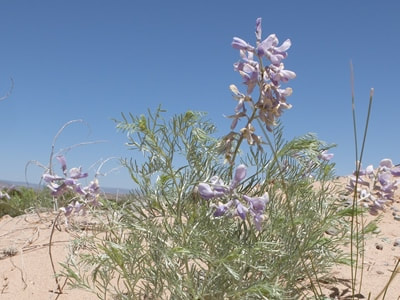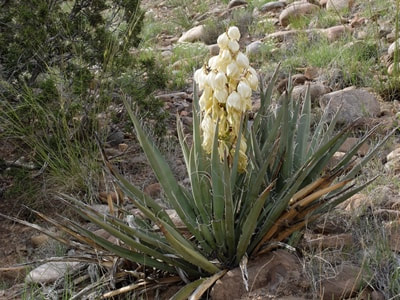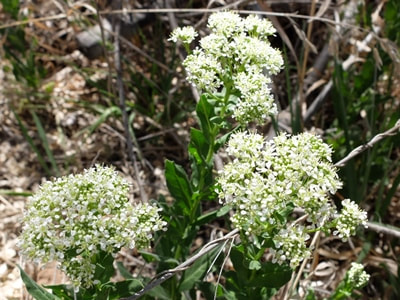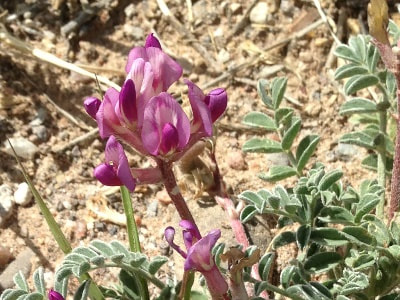|
Found on sandy slopes, piñon/juniper woodland
Seen blooming in May in Arroyo de los Pinavetes, Santa Fe NF Flowering plants are few and far between in our parched landscape. In my wanderings in search of blooms I have noticed that some species have not bloomed at all, not surprisingly, while others have bloomed a month earlier than usual. So, it was a very pleasant surprise to find many of these plants in bloom on the sandy bank of the arroyo. The Fringeleaf Necklacepod grows to 16 inches high in colonies from a deep underground root system. Leaves are silvery and narrow. Pea-like flowers are pale blue to purple. Narrow seed pods are 2 to 3 inches long and hairy with 1 to 5 seeds. No traditional uses of the plant were found but it contains alkaloids that are toxic to animals, like another species in this family, the locoweed. If you trying to identify a different flower then you can check what other flowers bloom this month. If you cannot identify a flower from the website, send a photo and where you took it to [email protected]. Read online for tips.
0 Comments
Found in canyons, dry openings, slopes
Seen blooming in May on Espinosa Trail, Santa Fe NF Banana Yucca is one of several yucca species that grow in our area. Its stiff, broad, bluish-green leaves grow to 2½ feet long with a sharp point and fibrous edges. The large, waxy flowers grow in drooping clusters on a stem about as tall as the leaves, although the flowers can extend above the plant. The other yuccas have narrower leaves and a flowering stem above the leaves. Most yuccas have dry hard fruits, but the fleshy fruits of the Banana Yucca can be 7 inches long and look like fat, green bananas. These fruits were a traditional food of several Native American tribes. They were prepared by roasting or baking, stripping out the seeds, pounding the remaining flesh into a pulp, forming the pulp into flat cakes, and sun-drying them for later use. Besides food, yuccas have other traditional uses. The leaf blades can be woven into baskets, used to make brushes, or with the fleshy leaf tissue removed the remaining stiff fibers can be made into a combination needle and thread. The roots are prized as a natural soap. These yuccas are often used in landscaping, as can be seen in front of Café Sierra Negra. Yuccas are the State flower of New Mexico. Source. If you trying to identify a different flower then you can check what other flowers bloom this month. If you cannot identify a flower from the website, send a photo and where you took it to [email protected]. Read online for tips. Found in disturbed soil, fields, roadsides
Seen blooming in May outside San Juan School, Ohkay Owingeh Whitetop grows to two feet tall in dense clumps with stout stems. Leaves are grayish-green and clasp the stems, basal leaves wither at flowering. Numerous tiny white flowers with four petals grow in flat-topped clusters two inches across. Seeds are heart-shaped. Whitetop is a very invasive species that spreads from its roots as well as by seeds, a single plant can produce 1,200 to 4,800 seeds. It is considered a noxious weed in New Mexico and many other states. As one of its common names, Wild Broccoli, implies, it is an edible plant. The edible parts are the young leaves and immature flower tops, which look like tiny florets of broccoli. Like many plants in the mustard family, they have a spicy hot-mustard flavor. Seeds are used as a pepper substitute. Medicinally, Whitetop has been used for preventing scurvy and as a bitter spring tonic. Source. If you trying to identify a different flower then you can check what other flowers bloom this month. If you cannot identify a flower from the website, send a photo and where you took it to [email protected]. Read online for tips. Found in dry, sandy, piñon-juniper woodlands, roadsides
Seen blooming in May at Abiquiu Lake and USPS Española There are more than 75 species of Astragalus in New Mexico, many with similarly colored pea-like flowers. The seed pods are often the best way to identify them, as is the case with the Crescent Milkvetch. It grows to about one foot high with grayish, arching leaflets. The stems and leaflets are covered in dense silvery hairs. Flowers grow in a cluster at the top of the stalk and are pink/purple, up to 1¼ inch long. Seed pods are about 1 inch long, slightly hairy and curved, crescent-shaped. Traditionally, a Zuni medicine man chewed a fresh or dried root before sucking out a snakebite and applied a poultice to the wound. Source. This is National Wildflower Week. You may find this article from the World Wildlife Fund inspirational. Join the SuperBloom and get free seeds. All we need is rain! If you trying to identify a different flower then you can check what other flowers bloom this month. If you cannot identify a flower from the website, send a photo and where you took it to [email protected]. Read online for tips. |
AuthorI am Marilyn Phillips, a native of England, whose love of nature and the outdoors from childhood brought me by a circuitous route to Crested Butte, Colorado in 1993 and 16 years later to northern New Mexico. My exploration of the many trails in these areas, my interest in wildflowers and photography, and career in computer system design came together in this creation. If you have any corrections, comments or questions, please contact me by email. Archives
July 2025
Categoriescopyright © 2020
|






 RSS Feed
RSS Feed